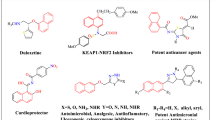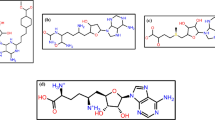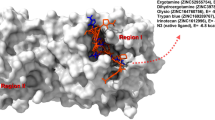Cell-based screening of a privileged small molecule library led to the discovery of 9-sulfonyl-9(H)-purine as new scaffold for hepatitis C virus (HCV) inhibitors. Structure–activity relationship study with respect to the 2-, 6- and 9-positions in the purine core resulted in the identification of several active compounds with moderate potency against the HCV genotype 1b. Subsequent stability studies demonstrated that HCV inhibitors of this type were unstable in Dulbecco’s modified eagle medium (DMEM) and plasma, as well as glutathione-containing water, and their instability was closely related to their HCV inhibitory activity. A preliminary study of the mechanism of action showed that the sulfonamide bond at the 9-position of purine would be the primary degradation site and the resulting sulfonylation degradation species would mediate the anti-HCV activity of 9-sulfonyl-9(H)-purines. Results of this study demonstrated that 9-sulfonyl-9(H)-purine is an unstable scaffold for HCV inhibitors and further detailed analysis of the degradation species is needed to determine the main active components and direct target for this type of molecules.






Similar content being viewed by others
References
M. P. Manns, M. Buti, E. Gane, et al., Nat. Rev. Dis. Primers, 3, 17006 (2017).
M. Götte and J. J. Feld, Nat. Rev. Gastroenterol. Hepatol., 13, 338 – 351 (2016).
T. Asselah, P. Marcellin, and R. F. Schinazi, Liver Int., 38, 7 – 13 (2018).
C. Sarrazin, J. Hepatol., 64, 486 – 504 (2016).
M. C. Sorbo, V. Cento, V. C. D. Maio, et al., Drug Resist. Update, 37, 17 – 39 (2018).
J. M. Pawlotsky, Gastroenterology, 151, 70 – 86 (2016).
G. A. Reed, Curr. Protoc. Pharmacol., 75, 7.6.1 – 7.6.12 (2016).
J. L. Romine, D. R. S. Laurent, J. E. Leet, et al., ACS Med. Chem. Lett., 2, 224 – 229 (2011).
N. Y. Wang, W. Q. Zuo, Y. Xu, et al., Bioorg. Med. Chem. Lett., 24, 1581 – 1588 (2014).
N. Y. Wang, Y. Xu, W. Q. Zuo, et al., J. Med. Chem., 58, 2764 – 2778 (2015).
W. Q. Zuo, N. Y. Wang, Y. Zhu, et al., RSC Adv., 6, 40277 – 40286 (2016).
X. Tao, N. Wang, J. Wang, et al, Antimicrob. Agents Chemother., 63(12), e01237 – 19 (2019).
R. Konsoula and M. Jung, Int. J. Pharm., 361, 19 – 25 (2008).
S. A. Yang, S. Choi, S. M. Jeon, and J. Yu, Sci. Rep., 8, 185 (2018).
L. Raj, T. Ide, A. U. Gurkar, et al., Nature, 475, 231 – 234 (2011).
B. Hassannia, B. Wiernicki, I. Ingold, et al., J. Clin. Investig., 128, 3341 – 3355 (2018).
T. Okamura, T. Kikuchi, K. Fukushi, et al., Bioorg. Med. Chem., 15, 3127 – 3133 (2007).
T. Okamura, T. Kikuchi, M. Okada, et al., J. Cereb. Blood Flow Metab., 29, 504 – 511 (2009).
U. Z. Paracha, K. Fatima, M. Alqahtani, et al., Virol. J., 10, 251 (2013).
K. B. Schwarz, Free Radical Biol. Med., 21, 641 – 649 (1996).
M. Yano, M. Ikeda, K. I. Abe, et al., Hepatology, 50, 678 – 688 (2009).
Acknowledgements
This work was supported by The National Science and Technology Major Project of China (2012ZX09103101-079) and Fundamental Research Funds for the Central Universities (No. A0920502051903-37).
CONFLICT OF INTEREST
The authors declare that they have no potential conflicts of interest.
Author information
Authors and Affiliations
Corresponding author
Rights and permissions
About this article
Cite this article
Hu, R., Wang, WL., Xiao, KJ. et al. 9-Sulfonyl-9(H)-Purine Derivatives Inhibit HCV Replication Via their Degradation Species. Pharm Chem J 55, 36–45 (2021). https://doi.org/10.1007/s11094-021-02369-1
Received:
Published:
Issue Date:
DOI: https://doi.org/10.1007/s11094-021-02369-1




